Physical Address
304 North Cardinal St.
Dorchester Center, MA 02124
5.1
Visit Expert Consult ( expertconsult.inkling.com ) for videos on topics discussed throughout the text.
Trichiasis is said to exist when the eyelashes are misdirected against the eye . Trichiasis is often seen in practice. Patients complain of a foreign body sensation. Discharge or conjunctival injection is rarely present. Let’s preview what is discussed in this chapter.
The most common cause of trichiasis is a form of mild cicatricial entropion known as marginal entropion . Subtle cicatricial changes of the posterior lamella pull the eyelid margin inward, misdirecting the eyelashes. The concept that most instances of misdirected lashes result from mild posterior lamellar shortening is important.
Accidental trauma may tear the lid margin. Frequently the lacerations are not sharp, and the tissue is swollen at the time of repair. Poor healing or inadequate alignment may cause misdirection of the eyelashes. Surgical trauma , such as a wedge resection, can lead to misdirected lashes if the lid margin alignment is not exact.
Two congenital conditions cause the eyelashes to rub against the eye:
Epiblepharon
Distichiasis
Epiblepharon is an unusual condition in which an extra roll of eyelid skin pushes the eyelashes against the cornea. Epiblepharon is most commonly seen in Asian children. Distichiasis is a rare congenital condition in which an extra row of eyelashes arises from the meibomian gland orifices. Although both these conditions are unusual, it is worth the effort to learn about them.
An understanding of the anatomy of the lid margin is necessary to identify the specific cause of the trichiasis. This was discussed in Chapter 4 and is reviewed in this chapter. The history and physical examination identify the exact cause of the misdirected lashes and point to the appropriate treatment. Marginal entropion of the lower eyelid is usually treated with an incisional rotation of the posterior lamella. This procedure, the tarsal fracture operation , works well for redirecting the lower eyelashes. Individual or small numbers of misdirected lashes may be ablated using cryotherapy , hyfrecation (electrolysis) , or laser epilation . Larger segments of misdirected lashes are best excised using the pentagonal wedge resection followed by meticulous lid margin repair. The misdirected lashes of epiblepharon are reoriented by removing an ellipse of skin and muscle under the eyelashes. The extra row of eyelashes seen in distichiasis is removed by a lid-splitting operation with cryotherapy to destroy the abnormal lashes arising from within the posterior lamella but retain the normal eyelashes arising from within the anterior lamella ( Box 5.1 ).
Marginal entropion
Trauma
Epiblepharon
Distichiasis
The understanding of trichiasis has come a long way in the last 20 years. There has been a major shift away from destructive procedures , such as cryotherapy, toward reconstructive procedures that reorient the lashes or provide a continuous row of lashes on a newly reconstructed lid margin. Learning the concepts in this chapter is helpful in treating many patients. With the exception of the operations for epiblepharon and distichiasis, all the procedures discussed are useful on a routine basis.
In Chapter 4 , we introduced the anatomy of the lid margin. You need to learn this anatomy well and pay close attention to anatomic details when evaluating a patient with misdirected lashes. The normal lid margin architecture is reviewed here before further discussion of trichiasis.
The lid margin is a thin, flat platform ending at right angles anteriorly and posteriorly ( Figure 5.1 ). The most posterior aspect of the normal lid margin is covered with conjunctiva. Anterior to this is the mucocutaneous junction . It is at this line that the mucosa of the palpebral conjunctiva stops and the keratinized skin of the eyelid margin begins. In Chapter 4 , I suggested that you look at several normal patients to see this junction. If you aren’t certain what this junction looks like, review it again when you examine one of your normal patients. If you can’t identify it, ask a colleague for help. It is important to be able to see these landmarks.
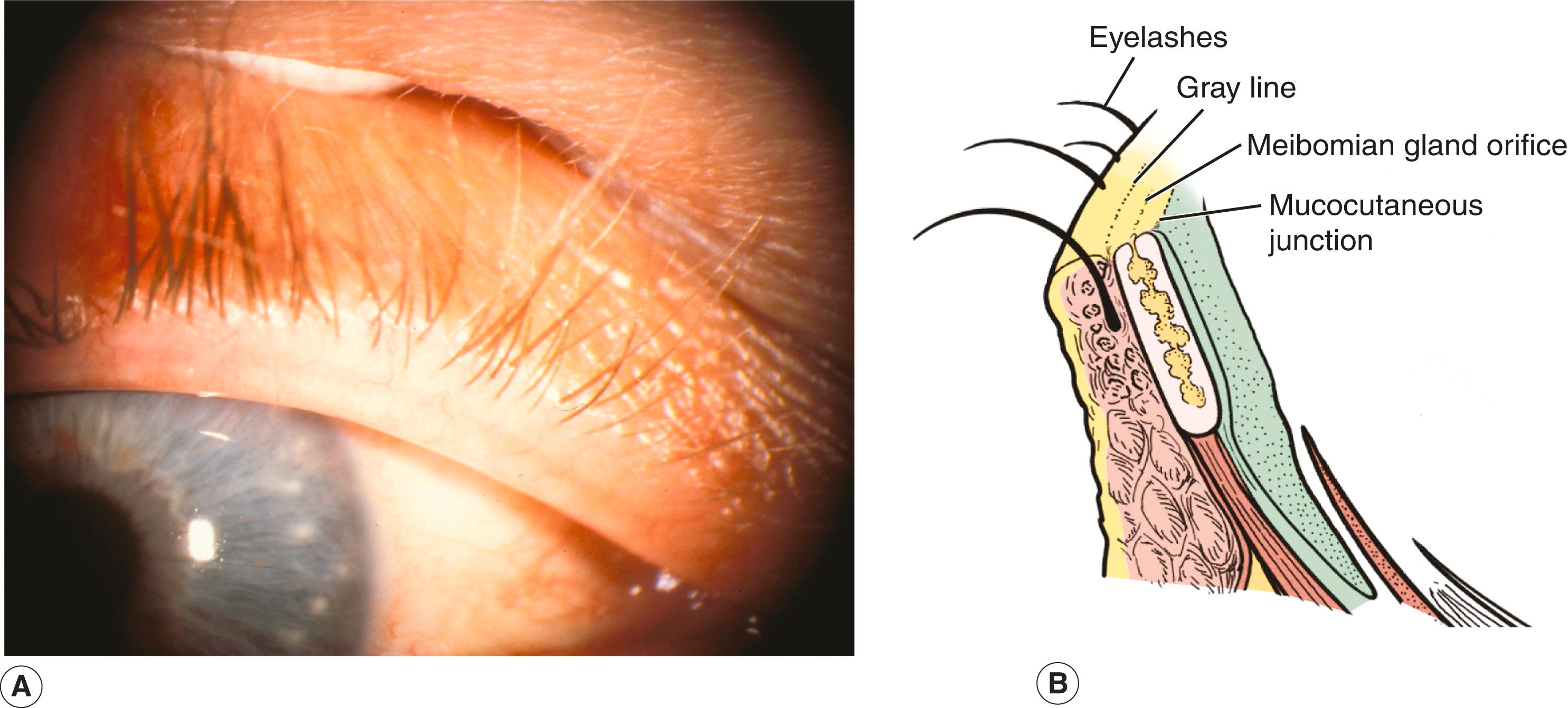
Just anterior to the mucocutaneous junction are the meibomian gland orifices extending out from the tarsal plate. Anterior to the meibomian gland orifices is the gray line (the most superficial extent of the orbicularis muscle, known as the muscle of Riolan). Anterior to the gray line is the anterior lamella, which includes the skin and muscle. The eyelashes arise anterior to the gray line, usually in one or two irregular rows in the lower lid and three or four irregular rows in the upper lid. Learn these anatomic landmarks during a slit lamp examination.
The causes of trichiasis are easy to understand on an anatomic basis:
Marginal entropion : Posterior lamellar shortening pulls the eyelashes posteriorly toward the eye ( Figure 5.2 ).
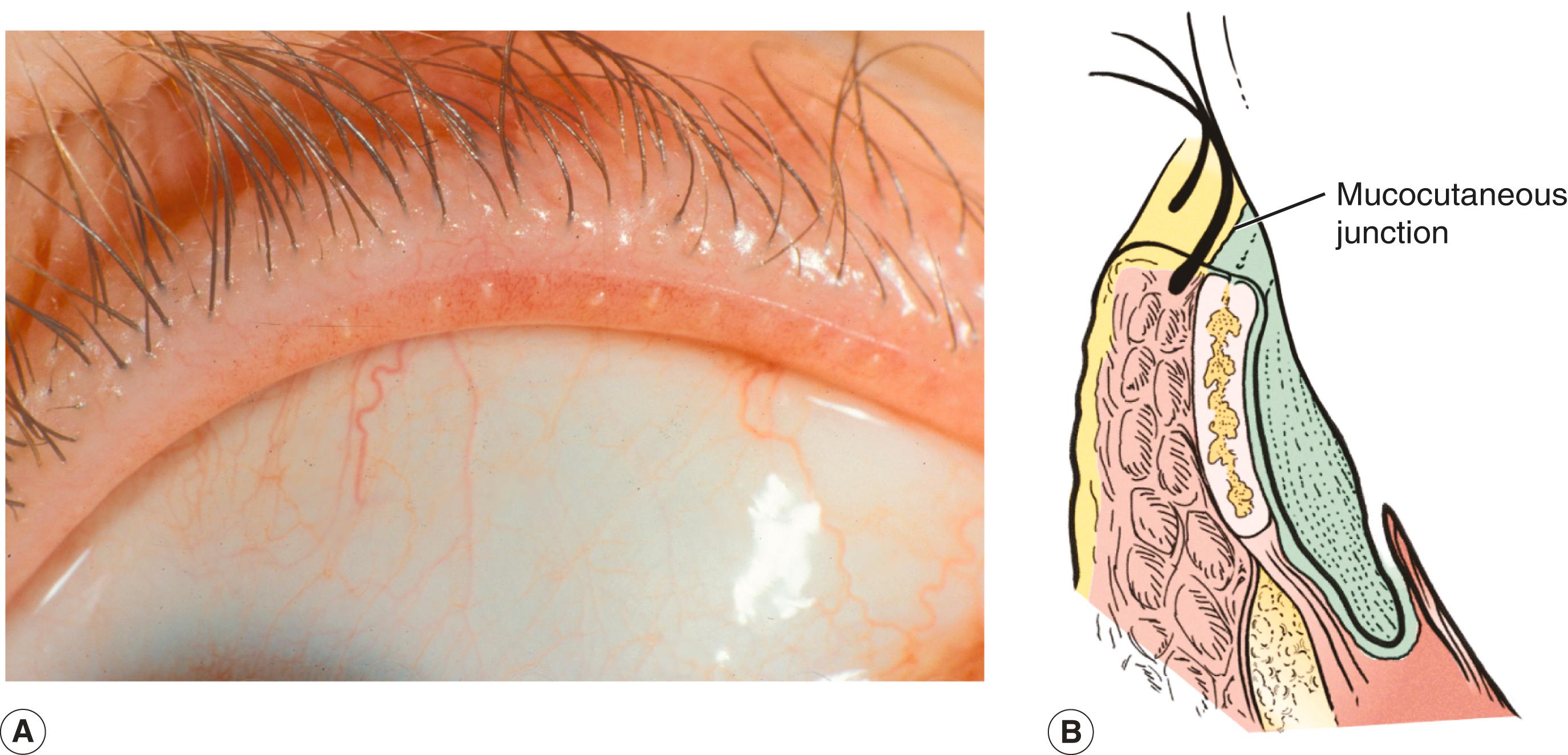
Traumatic misdirection of eyelashes : The position of eyelash follicles or surrounding tissues is physically altered, which causes the eyelashes to grow in an irregular manner, pointing in different directions and sometimes toward the eye ( Figure 5.3 ).
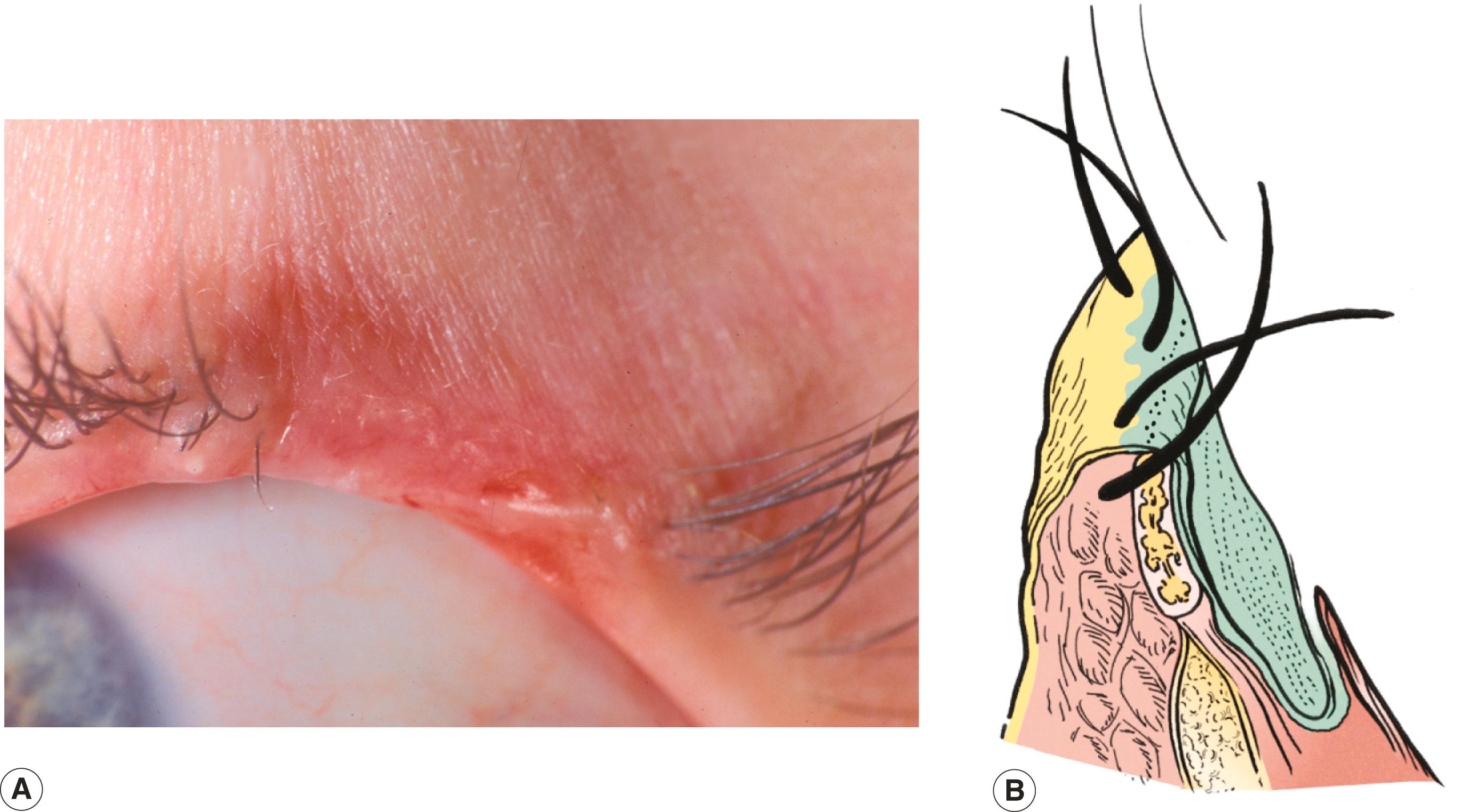
Epiblepharon : A roll of extra skin pushes the normal eyelashes against the eye ( Figure 5.4 ).
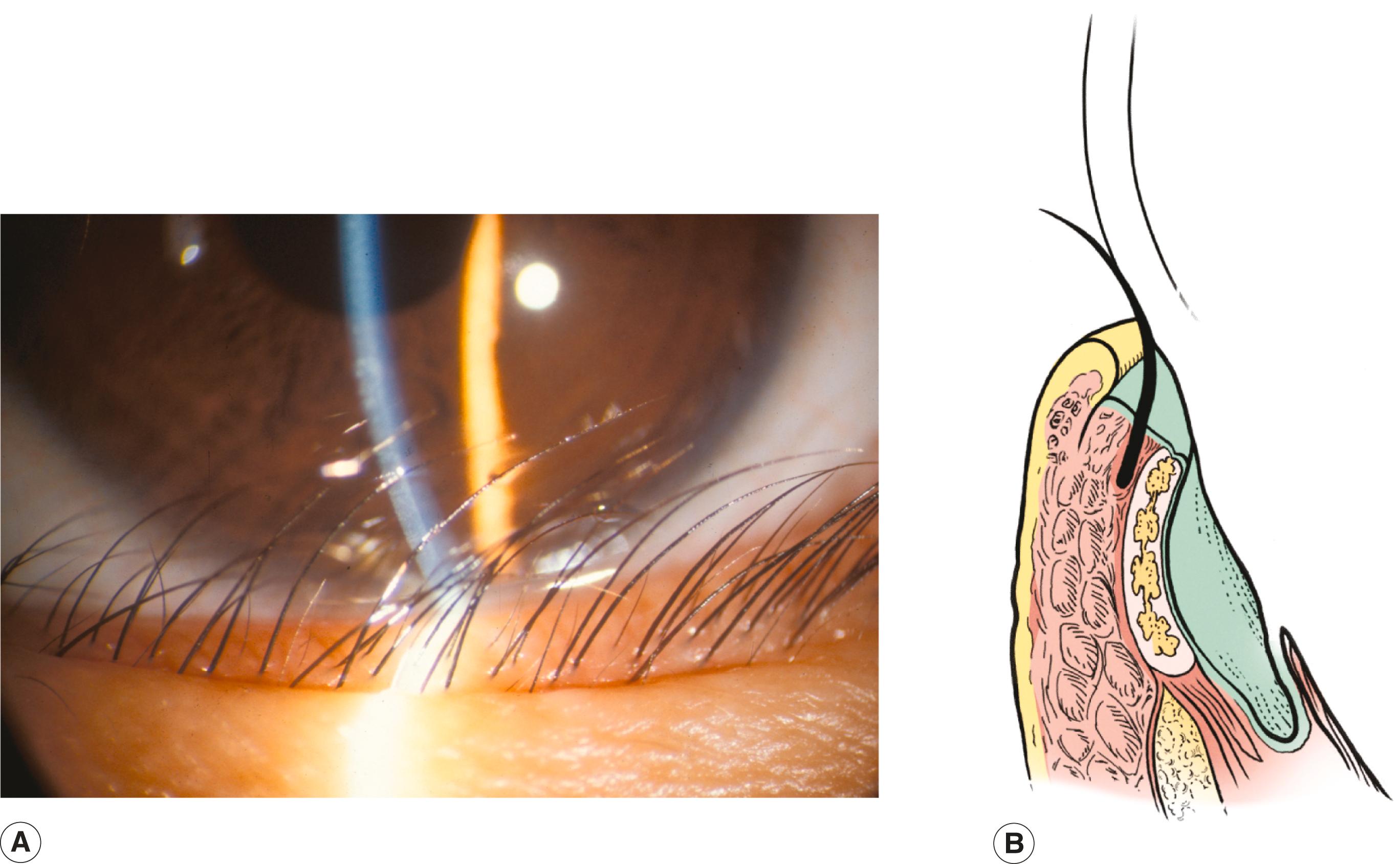
Distichiasis : An incomplete row of eyelashes arises abnormally from the meibomian glands ( Figure 5.5 ).

Many older textbooks define trichiasis as a condition in which the eyelashes are misdirected and the lid margin is in normal position . This definition stressed that the condition was an eyelash problem, not an abnormality of the eyelid. Eyelid malpositions such as involutional entropion and cicatricial entropion were not (and generally still are not) considered to be causes of trichiasis because the lid margin is obviously inverted ( Figure 5.6 ). Now that we have a greater appreciation of the lid margin architecture, we realize that many (probably most) cases of trichiasis are actually the result of subtle inversion of the lid margin, marginal entropion. From a semantic point of view, somewhere along the spectrum of severity, the trichiasis of marginal entropion becomes a cicatricial entropion. Figure 5.7 is an example of this. The definition of trichiasis is not as important as understanding the mechanics of the misdirected lashes. As you have seen, epiblepharon and distichiasis are usually included in the discussion of trichiasis because the lid margin is in a normal position. In this book, the terms misdirected eyelashes and trichiasis are used interchangeably.
Review the anatomic landmarks of the eyelid margin. What are the four causes of misdirected eyelashes ( Boxes 5.1 and 5.2 )?
Marginal entropion: Posterior lamellar shortening pulls the eyelashes posteriorly toward the eye.
Traumatic misdirection of eyelashes: The position of the eyelash follicles or surrounding tissues is physically altered, causing the eyelashes to grow in an irregular manner pointing in different directions, sometimes toward the eye.
Epiblepharon: A roll of extra skin pushes the normal eyelashes against the eye.
Distichiasis: An incomplete row of eyelashes arises abnormally from the meibomian glands.
You should understand the mechanics of each cause. Describe the changes in the anatomic landmarks of the lid margin for each cause.
Remember that the most common cause of trichiasis is marginal entropion.
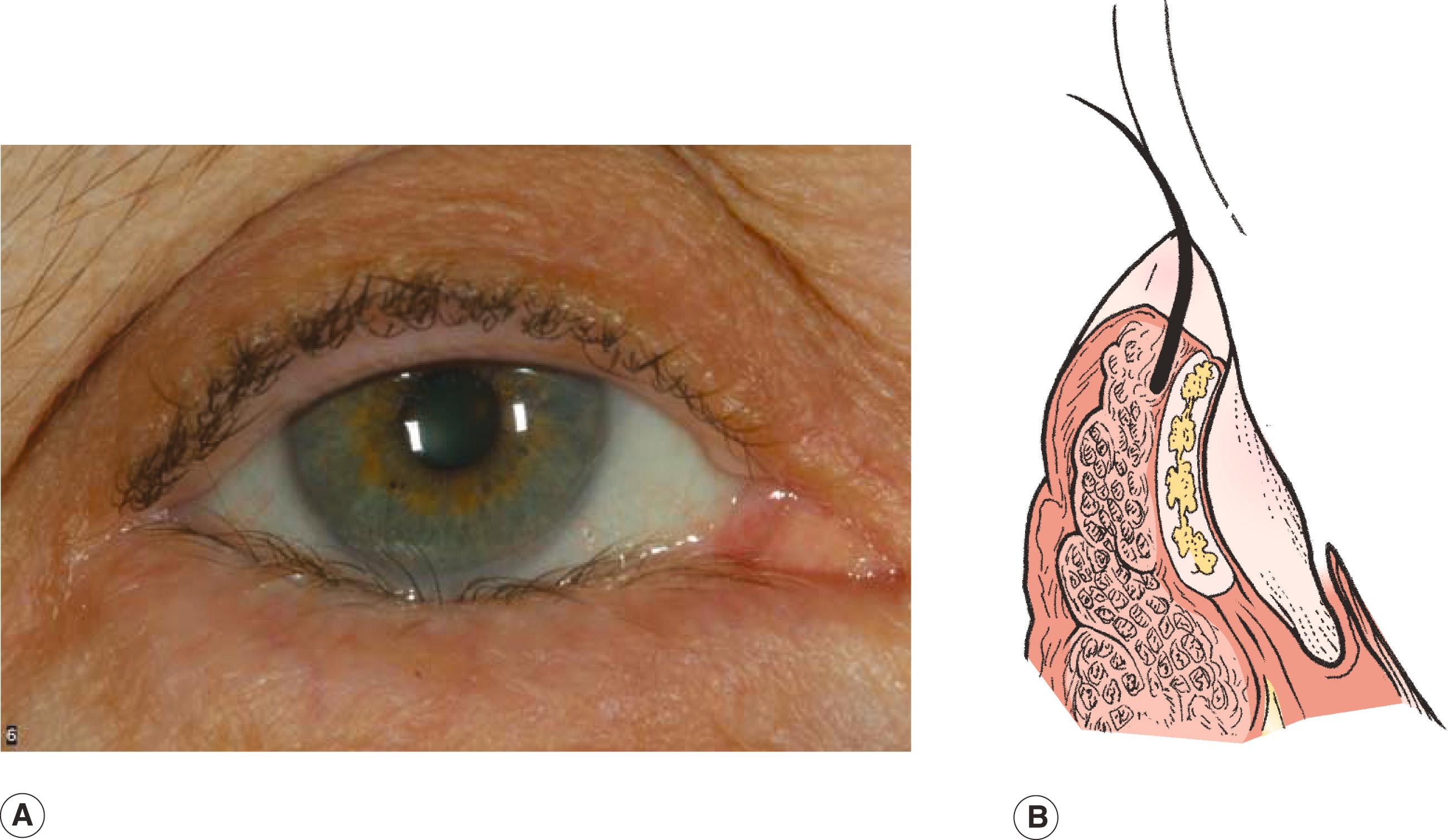
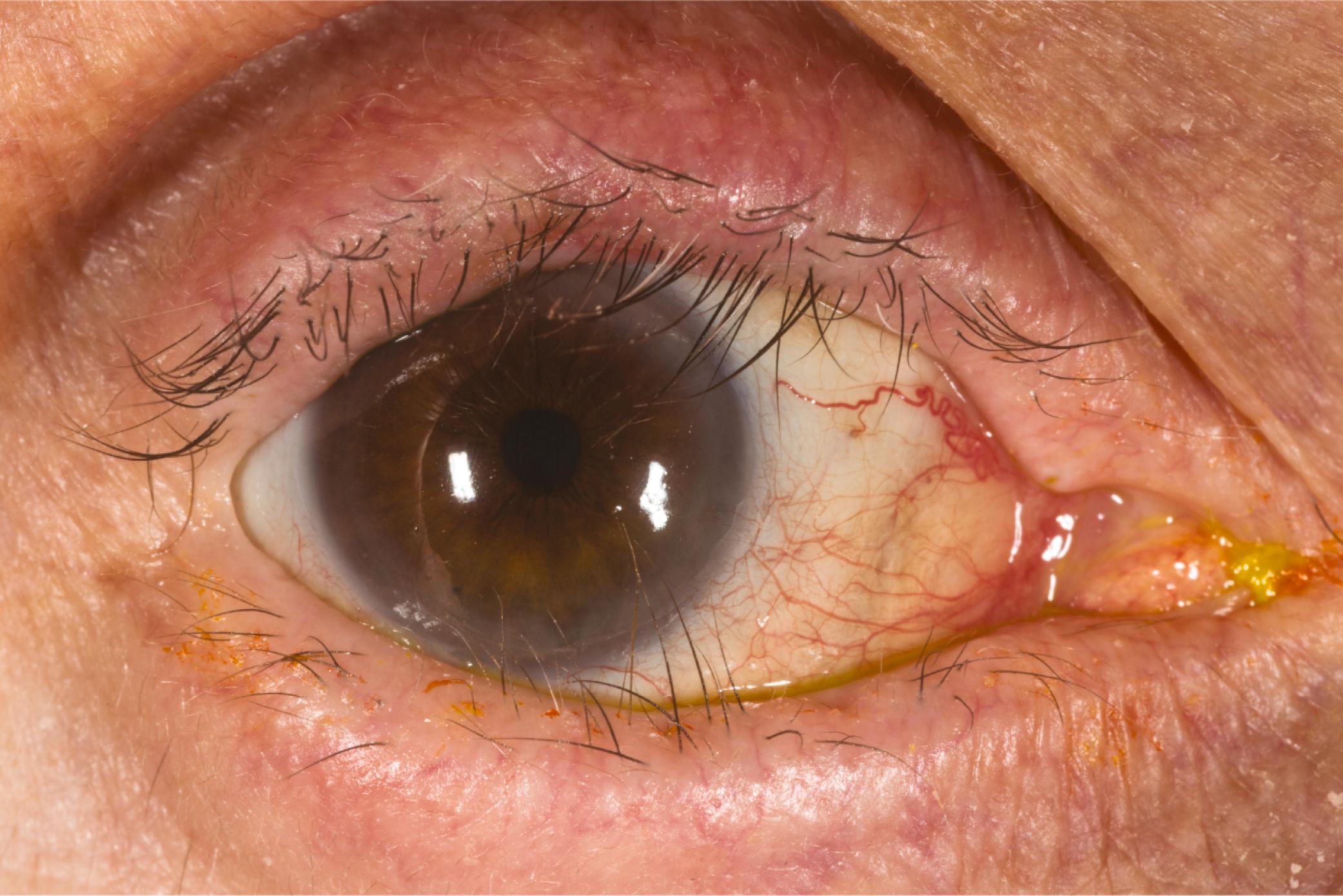
Most adults with misdirected lashes complain of a foreign body sensation. Often, patients epilate the lashes themselves to eliminate the symptoms. Usually, patients can’t remember when the symptoms started or what caused the problem. Some patients may tell you that the problem started after trauma, an infection, or an operation.
With epiblepharon and distichiasis, the age of presentation varies, but is often not until age 4 or 5. Children usually don’t complain of irritation. More commonly, children rub the eye or have associated tearing and mild discharge. Photophobia suggests significant corneal irritation. I use the presence of symptoms of photophobia as a strong indication for treatment.
Become a Clinical Tree membership for Full access and enjoy Unlimited articles
If you are a member. Log in here